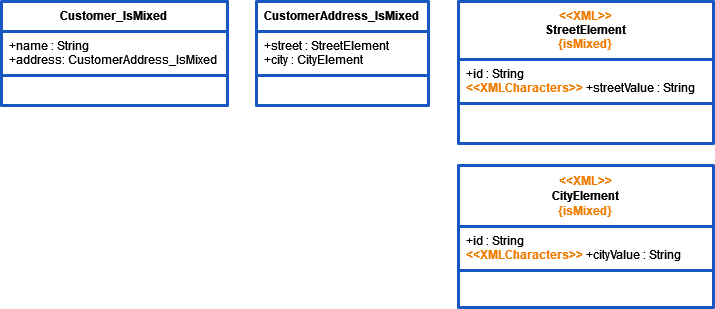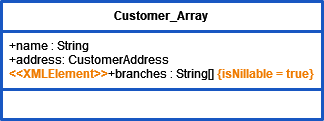Attributes
| Tagged Value | Stereotype | Description | Allowed Values | |
|---|---|---|---|---|
| Classes | ||||
| xmlNamespace | XML | Specify the XML namespace. | a valid namespace | |
| xmlElementName | XML | Specify the name of the XML root element. | a valid element name | |
| isMixed | XML | Specify whether the XML contains mixed content, means attributes that are serialized as character stream (attributes with stereotype XMLCharacters, see also Stereotypes above). | true | XML contains serialized attributes. |
| false | XML does not contain serialized attributes (default). | |||
| isOrdered | XML | Specify whether the class properties should be serialized to XML using the order tag that has been specified on the properties. | true | Serialize in order of order tags from the properties. |
| false | Serialize in order of property definition on class (default). | |||
| Property | ||||
| xmlNamespace | XMLElement XMLAttribute | Each XML attribute and element may have its own namespace. If this attribute contains an URI, the Runtime will automatically generate a unique prefix. Examples:
| an URI | |
| a valid xlmns syntax | ||||
| xmlForm | XMLElement XMLAttribute | Depending on this tagged value, XML elements or attributes may not be qualified by a namespace prefix even if they have one. | qualified | The element or attribute must always be qualified by a namespace prefix. Default for XML elements. |
| unqualified | No namespace prefixes are allowed (for details see http://www.w3.org/TR/xmlschema-0/#NS). Default for XML attributes. | |||
| xmlFormat | XMLElement XMLAttribute XMLCharacters | If numbers and date/time types are parsed or composed, the XML parser respectively composer expects simple date types following the XML schema specification. However, legacy XML documents may contain different number and date/time formats. In this case, the tagged value xmlFormat may hold a format string.
| a valid format string (see Number Formatting or Date and Time Formatting) | |
| CDATA | Compose string as CDATA. | |||
| isNillable | XMLElement | By default, properties that are NULL are not serialized into XML documents. However, if it is necessary to do so, you can set isNillable to true. In this case, NULL properties will look like: | true | Serialize NULL properties. |
| false (default) | Do not serialize NULL properties. | |||
| order | XMLElement | Use order to specify the order in which the XML elements will be generated to the XML document. | a valid float | |
| externalName | XMLElement XMLAttribute | Sometimes names of XML attributes or elements do not comply with the rules specified on Syntax Scheme of the xUML Action Language. Use externalName to specify the name of the XML attribute or element, and specify a valid name for the property for internal usage. | ||
Examples
Serializing Mixed Content XML to a Class Structure
The following example shows how to depict an XML data structure with mixed content with a class in the data model of the Designer.
Suppose you want to build the following customer XML data structure, with two elements street and city:
<?xml version="1.0" encoding="utf-8"?> <customerIsMixed name="Summer Ltd."> <address> <street id="Summer Ltd.">456, Sunny Beach</street> <city id="Summer Ltd.">Miami, FL 33101</city> </address> </customerIsMixed>
This is mixed content XML because the street and city elements have attributes ( id="Summer Ltd." ) and element ( 456, Sunny Beach ) values.
The class diagram below illustrates how you need to build the class structure to serialize the mixed content. The stereotypes you should specify, and the related attributes you should set are highlighted in orange.
| XML Element/Attribute | Representation in Class Structure | ||
|---|---|---|---|
| address | To serialize the XML element address, you need a dedicated class ( CustomerAddress_IsMixed in this case). | ||
street | address contains the sub-element street. To serialize XML element street and its attribute id, you need a dedicated class as a container (class StreetElelement in the example class diagram). XML attribute id of element street is serialized to class property id of class StreetElement via matching names. The content of the XML element street is serialized to the class property that has stereotype XMLCharacters. In the example, this is streetValue. Container StreetElement is associated to the main address class. The name of the association end (street) must match the name of the XML element. Associated class StreetElement is only a container for the street element and its name is not relevant for the serialization. The same applies to city. |
Arrays and XML Serialization
The behavior of XML serialization in this case is not always self-explanatory. This is a consequence of the definition of arrays in XML schema.
The table below shows the behavior of XML serialization for the following class structure containing an array (branches). The necessary stereotypes and attributes are highlighted in orange.
{
"customerArray" : {
"name" : "Summer Ltd.",
"branches" : ["Miami", "Orlando", "Tampa"]
}
}
|
| Description | XML result |
|---|---|
| All values are present. | <customerArray name="Summer Ltd.">
<branches>Miami</branches>
<branches>Orlando</branches>
<branches>Tampa</branches>
</customerArray>
|
| The second value is NULL and isNillable=false. | <customerArray name="Summer Ltd.">
<branches>Miami</branches>
<branches>Tampa</branches>
</customerArray>
|
| The second value is NULL and isNillable=true. | <customerArray xmlns:xsi="http://www.w3.org/2001/XMLSchema-instance" name="Summer Ltd.">
<branches>Miami</branches>
<branches xsi:nil="true"/>
<branches>Tampa</branches>
</customerArray>
|
| The array is NULL or the array is empty or all elements are NULL and isNillable=false. | <customerArray name="Summer Ltd."> </customerArray> |
| All elements are NULL and isNillable=true. | <customerArray xmlns:xsi="http://www.w3.org/2001/XMLSchema-instance" name="Summer Ltd.">
<branches xsi:nil="true"/>
<branches xsi:nil="true"/>
<branches xsi:nil="true"/>
</customerArray>
|

